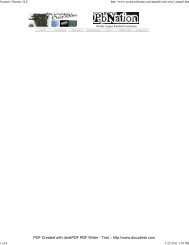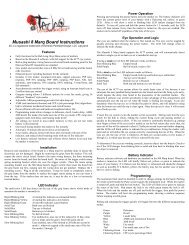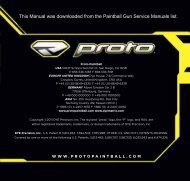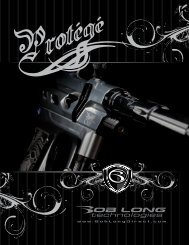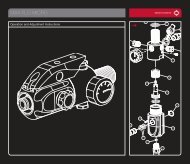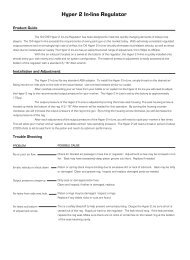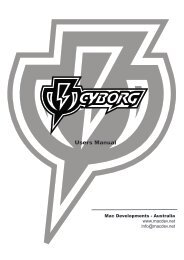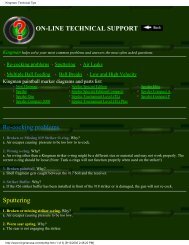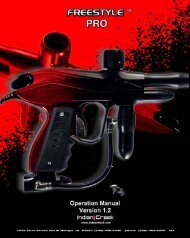Mikko Huttunen Ultralite Board - Tadao Technologies
Mikko Huttunen Ultralite Board - Tadao Technologies
Mikko Huttunen Ultralite Board - Tadao Technologies
You also want an ePaper? Increase the reach of your titles
YUMPU automatically turns print PDFs into web optimized ePapers that Google loves.
1. Features<br />
2. Installation<br />
3. <strong>Board</strong> Operation<br />
4. OLED Diagrams<br />
5. Menu System<br />
6. Settings<br />
7. Recommendations<br />
<strong>Mikko</strong> <strong>Huttunen</strong> <strong>Ultralite</strong> <strong>Board</strong><br />
FEATURES<br />
• Fully functional in <strong>Ultralite</strong> frames for the DM8, DM7, DM6, DM5, PM8, PM7, PM6, and PMR<br />
• Includes both wired and ribbon style eye harness sockets so no adapters or additional eye sets are needed<br />
• Yakuza Series OLED graphical display system shows eye status, battery life, current fire mode and max<br />
rate of fire, game timer, and menu system<br />
• Includes super thin grip panels with a window for the OLED display<br />
• Advanced microcontroller running at 16 Mhz<br />
• Fully legal in the NPPL, PSP, and Millennium tournament series<br />
• Anti-breech bounce software to reduce chopping when a loader is running out of paintballs<br />
• RF socket and wiring harness included to support Magna, Pulse, and other RF transmitters<br />
• Multiple modes of fire: unlimited semi-automatic, adjustable semi-automatic, PSP ramping, PSP 3-round<br />
burst, NXL full-automatic, Millennium, custom ramping, auto-response, 3-round burst, and full-automatic<br />
• <strong>Tadao</strong> trigger logic asynchronously monitors the trigger switch, using an interrupt based scan at 4 million<br />
times per second for the quickest response time and fastest semi-automatic<br />
• <strong>Tadao</strong> dynamic eye logic watches for the bolt to return every shot, cycling the marker as fast as possible<br />
• Rate of fire adjustable from 10 to 30 bps, plus unlimited rate of fire, and a 0.5 ms fine-tuning setting<br />
• Adjustable ABS programming eliminates first shot drop-off<br />
• AMB (anti-mechanical bounce) and CPF (cycle percentage filter) algorithms help to prevent mechanical<br />
and switch bounce without missing real trigger pulls<br />
• G-mode setting allows 3 different breakout options for every fire mode<br />
• More than 1 billion unique ways to adjust settings<br />
• Extremely easy to use graphical and text based menu system, which allows changes to nearly any variable,<br />
including debounce, dwell, loader delay, AMB, anti-bolt stick, fire mode, max rate of fire, fine rate of fire<br />
adjustment, eye mode, CPF, g-mode breakout, ramp start, ramp percentage, screen settings, settings<br />
profiles, and more<br />
• All settings are stored in non-volatile memory so they are not lost when the battery is disconnected<br />
• Power-efficient software and hardware lengthen battery life<br />
• Automatic 20-minute idle power down saves batteries<br />
• One-touch startup enables the marker to fire almost instantly<br />
• Uses spring battery contacts so there’s no wiring harness to break or wear out<br />
• 80 gram trigger microswitch<br />
• Lifetime warranty against manufacturing defects<br />
• Free Yakuza software updates at selected NPPL and PSP events<br />
INSTALLATION<br />
Installation of the Yakuza board must be carefully done to avoid damaging the electronics or wiring harnesses.<br />
1. Remove the grip panel from the right side of the grip frame, exposing the battery and circuit board.<br />
2. Remove the battery and unplug the eye and solenoid harnesses.<br />
3. Remove the 2 mounting screws.<br />
4. Gently pull the stock board out of the frame.<br />
5. Make sure to keep track of the 2 switch contacts.<br />
6. Insert the Yakuza board into the grip frame.
7. Replace the 2 mounting screws, making sure the power switch and eye switch sit snugly against the switch<br />
contacts.<br />
8. Plug the eye and solenoid harness back into the appropriate sockets.<br />
9. Replace the battery. The positive terminal is towards the rear of the frame, as shown by the + and – marks<br />
on the surface of the board.<br />
10. Replace the grip panels.<br />
BOARD OPERATION<br />
Turn on the board by pushing the power switch. The OLED display will show the boot screen, followed by the main<br />
screen with the current fire mode, rate of fire, battery, and eye status visible.<br />
Turn off the board by pressing and holding the power switch for at least 1 second. The OLED display will turn off<br />
to indicate the board has shut down.<br />
The eye system is toggled on and off by pressing and holding the eye switch. The OLED display will reflect the eye<br />
status by changing the eye indicator.<br />
If used, the eye system cycles the marker as fast as possible. During each shot the eyes watch for the bolt to return,<br />
ending the current firing cycle and starting another as quickly as the pneumatics allow. If the eye system is<br />
continually blocked (e.g., putting your finger in front of the eyes) and is unable to see the bolt return after every<br />
shot, the max rate of fire will be reduced to about 8 balls per second to prevent further chopping, and the OLED<br />
display will display an eye malfunction. Firing the marker with paint and air will utilize the eye system correctly,<br />
maximizing the rate of fire.<br />
The programming menu system is activated by holding down the trigger while pressing the power switch. The<br />
OLED display will show “Menu system initiated….” Further details regarding the menu system can be found<br />
below.<br />
If selected in the menu system, the game timer will replace the current rate of fire indicator on the OLED display.<br />
The game timer can be started by pressing and releasing the power switch quickly while the timer is displayed.<br />
OLED DIAGRAMS<br />
The OLED display built into the Yakuza series board shows the user a multitude of information via text and icons.<br />
The software is written with performance in mind, and will not update the screen until the user stops shooting for<br />
just a fraction of a second. This ensures that screen updates do not interfere with the timings of the marker.<br />
Main screen showing rate of fire:<br />
Main screen showing game timer (when enabled):<br />
The battery indicator shows battery life by displaying bars within the icon. The more bars, the higher the battery<br />
level. A low battery (1 bar) is reached at approximately 7.5 volts, but if quality alkaline batteries are used, the<br />
remaining power should be adequate for at least 1 more case of paint.<br />
The eye indicator is displayed as a circular icon, showing the eye status. If the eye system has a malfunction from<br />
not seeing the bolt return, it will show a circle with an X.<br />
Empty breech:<br />
Eyes blocked:<br />
Eye malfunction, bolt not seen returning:<br />
Eyes off:<br />
MENU SYSTEM<br />
The Yakuza menu system allows the user to quickly and easily change a multitude of settings. The text based menu<br />
is much faster and easier to understand than LED based programming modes.
Tournament lock: The tournament lock can be toggled on and off by pressing the small switch located beside the<br />
battery on the surface of the board while the marker is turned off. Each press will disable or enable the tournament<br />
lock, and display the lock status on the OLED screen.<br />
Programming mode: To boot into programming mode the tournament lock must be off. The user can then hold<br />
down the trigger while pressing the power switch to boot into programming mode. After the menu boot message,<br />
the displayed setting will be the last one that was modified. If this is the first time the board has been booted into the<br />
menu system, it will show the fire mode.<br />
Scroll through the settings by pulling and releasing the trigger. The menu will wrap around to the beginning when<br />
the last setting is reached.<br />
To change a setting the user must quickly press and release the power switch. The OLED screen will reflect this by<br />
displaying “set” in front of the current value. The setting can be modified at this point by pulling and releasing the<br />
trigger, which will advance the current value. Once you reach its maximum or last value, it will loop back to the<br />
lowest value. After the desired value is displayed, you can save the setting by pressing the power switch. The “set”<br />
designation next to the value will disappear.<br />
Example to change the maximum rate of fire from 15 to 20:<br />
1. Boot into programming mode by holding the trigger while pressing the power switch.<br />
2. The first setting is fire mode:<br />
3. Pull and release the trigger 1 time to advance to the next setting, which is the maximum rate of fire:<br />
4. Press and release the power button quickly. The OLED screen will display the “set” designation next to the<br />
current value for maximum rate of fire:<br />
5. Pull and release the trigger 5 times to increment the value from 15 to 20:<br />
6. Press and release the power button quickly. The OLED screen will remove the “set” designation from view<br />
and save the setting:<br />
7. Cycle through additional settings using the trigger, or exit programming mode by holding the power switch<br />
for 1second, until the OLED screen turns off.<br />
SETTINGS<br />
Fire mode (default semi-automatic unlimited)<br />
1. Semi-automatic unlimited<br />
2. Semi-automatic adjustable<br />
3. PSP ramping – 123 shots semi, on 4 th shot ramps at 5 pulls per second, resets after 1 second<br />
4. PSP burst – 123 shots semi, on 4 th shot fires 3-round burst, resets after 1 second<br />
5. NXL full-automatic – 123 shots semi, on 4 th shot fires full-automatic, resets after 1 second<br />
6. Millennium ramping – 123 shots semi, on 4 th shot ramps at 6 pulls per second, ignores ramp start<br />
setting if less than 6 pulls per second, resets after 1 second<br />
7. Custom ramping – user adjustable ramping, select custom ramp start and ramp percentage<br />
8. Auto response – fires on each pull and release<br />
9. Burst – 3-round burst<br />
10. Full-automatic – 1 shot semi, on 2 nd shot fires full-automatic, resets after 1 second<br />
Maximum rate of fire (default 13 bps, range 10-30 and infinity)<br />
The semi-automatic unlimited fire mode ignores this value, making it easy to switch back and forth between NPPL<br />
and PSP gun rules without modifying more than one setting. Adjustable from 10 to 30, with an unlimited option<br />
designated by the infinity symbol.<br />
Fine rate of fire timing (default 0.0, range -2.5 to +2.5)<br />
Allows fine adjustment of the maximum rate of fire in 0.5 millisecond increments, from -2.5 to +2.5 milliseconds.
Game timer (default off, range 1-20)<br />
Enables and sets the game timer, which replaces the rate of fire indicator on the OLED display when turned on.<br />
The game timer is adjustable from 1 to 20 minutes, and automatically adds the 10-second countdown prior to game<br />
start. For game timer use please refer to the <strong>Board</strong> Operation section.<br />
Debounce (default 10 ms, range 1-25)<br />
The amount of time the trigger must be released for the microcontroller to allow the next trigger pull. The Yakuza<br />
series uses an asynchronous interrupt-based scan at 4 million times per second that is run independently from code<br />
execution. This ensures that every trigger pull is registered. Higher values reduce bounce. Lower values cause<br />
more bounce.<br />
Anti-mechanical bounce (default 1, range 1-4)<br />
Helps eliminate mechanical bounce which can cause a loosely held paintball marker to go full-auto when the trigger<br />
is pulled slowly.<br />
Cycle percentage filter (default 2, range 1-10)<br />
Secondary debounce filter which adjusts how far into the firing cycle additional buffered shots are allowed. A<br />
setting of 1 turns this filter off, while settings 2 through 10 set the percentage of the cycle that must pass before shots<br />
may be buffered. Higher settings will reduce bounce.<br />
Dwell (default 18 ms, range 2-30)<br />
The amount of time the solenoid is energized during each firing cycle. Low dwell times can lead to inconsistency<br />
and drop-off. High dwell times can cause bad air efficiency.<br />
Anti-bolt stick (default off, range 1-10)<br />
Bolt stick can occur when the o-rings in the bolt settle or stick, causing the next shot to have lower velocity. If the<br />
marker is left sitting for more than 20 seconds, ABS adds extra dwell to ensure the next shot has proper velocity.<br />
The default is off.<br />
BIP delay (default 1, range 1-10)<br />
A slight delay that allows each paintball to settle in the breech before firing. Lower settings potentially lead to<br />
higher achievable rates of fire.<br />
Bolt delay (default 5, range 1-15)<br />
A delay time that gives the bolt enough time to block the eyes on the forward stroke. Too low of a bolt delay will<br />
cause blank or skipped shots. Too high of a setting can limit the maximum rate of fire.<br />
Eye mode (default forced)<br />
1. Forced with force shot – marker only fires when a paintball is present, unless a force shot is initiated by<br />
holding down the trigger for ½ second.<br />
2. Delayed – the eyes will watch for a paintball for up to 500 ms after each pull, then fire. This is useful for<br />
sound activated loaders and was the stock setting on original Intimidators.<br />
Ramping start (default 5, range 4-14)<br />
Adjusts how fast a user must pull for the ramping fire modes to start adding additional shots. Used with the PSP<br />
ramping, Millennium ramping, and custom ramping fire modes.<br />
Ramping percent (default 500%, range 10%-500%)<br />
Adjusts how much the software helps the user. A 50% ramp will add 50% of the user’s pulling rate to the current<br />
rate of fire (e.g., if you pull 8 times per second, it will add an additional 50%, meaning the gun will fire 12 times per<br />
second).<br />
G-mode or “breakout mode” (default off)<br />
This breakout setting provides unlimited full-auto, which then falls back to the user-selected fire mode, on the 1 st ,<br />
2 nd , or 3 rd shot after turning the board on. Breakout modes are illegal for use in all tournament series and most<br />
recreational paintball fields. <strong>Tadao</strong> <strong>Technologies</strong> LLC takes no responsibility if a player chooses to use<br />
breakout modes.<br />
Screen Orientation (default left)<br />
Allows the user to configure the orientation of the screen. Available options are left and right landscape, or vertical.
Rate of fire/Timer size (default big)<br />
Allows the user to pick the text size for the current rate of fire or game timer display on the OLED screen. The<br />
available options are “normal” and “big.”<br />
Rate of fire display mode (default maximum)<br />
1. Maximum – displays the highest achieved rate of fire based on the shortest time between any 2 shots.<br />
2. Average – displays the average rate of fire of the last 5 shots.<br />
Brightness (default 5, range 1-5)<br />
Allows adjustment of the OLED display brightness. Lower settings are less bright, with a setting of 1 useful for<br />
night play and scenario games.<br />
Save profile<br />
Allows the user to save his current settings in one of 3 profiles which are not deleted by a settings reset.<br />
Load profile<br />
Allows the user to load any previously saved settings profiles.<br />
Reset<br />
Allows the user to perform a settings reset, which returns all settings to their default values. Saved profiles will not<br />
be reset.<br />
Version<br />
Displays the current software version running on the Yakuza series board.<br />
RECOMMENDATIONS<br />
Settings<br />
The Yakuza series ship with default settings which are tuned for a wide range of trigger adjustments and general<br />
usage. Certain tournament series allow alternate fire modes with specific characteristics, so the following is a list of<br />
settings that will give you a baseline. Ultimately, every marker is unique and may require different settings for<br />
optimal performance.<br />
NPPL: Use the default settings, possibly only changing debounce, AMB, and CPF to suit your personal trigger<br />
adjustments.<br />
PSP: Use the PSP ramping or PSP burst fire modes, with maximum rate of fire set to the required cap for the league<br />
(for 2007 this was 15 bps). Make sure debounce is near default values.<br />
NXL: Use the NXL full-automatic or PSP fire modes. See PSP for maximum rate of fire recommendations.<br />
Millennium: For 2008 the Millennium series modified their rules slightly. It is now a 12 bps cap with a 6 pulls per<br />
second activation, and requires the 1-2-3 semi-auto shots like PSP mode before ramping can begin.<br />
Use the specific Millennium mode. The ramp start will automatically be set to 6 pulls per second as required by the<br />
Millennium series unless a higher value is selected. Maximum rate of fire must be manually set to 12 bps.<br />
Many European tournaments besides the Millennium series utilize semi-automatic, but capped at 15 bps. Select the<br />
capped semi-automatic fire mode for these events.<br />
Care and cleaning<br />
Your Yakuza series board includes a conformal coating to help protect against damage caused by moisture such as<br />
broken paint or rain. Under normal conditions the board should continue to operate, even with small amounts of<br />
moisture present. However, paint is slightly corrosive and can destroy the conformal coating over time. In the event<br />
that you get broken paint or water on the electronics, unplug the battery and use rubbing alcohol and a blast of<br />
compressed air to clean the board off. The compressed air will ensure that everything is cleaned out from beneath<br />
the components and connectors.<br />
Batteries<br />
<strong>Tadao</strong> <strong>Technologies</strong> recommends the use of quality alkaline batteries such as those made by Duracell and Energizer.<br />
Photo lithium 9 volt batteries are also adequate. Batteries labeled as “heavy duty” or “super heavy duty” are not true
alkaline and will cause inconsistent operation, or may not properly power the electronics. Rechargeable batteries are<br />
also not recommended because they typically do not provide enough current.<br />
Trigger adjustment and switch life<br />
The trigger switch used on the Yakuza series boards is a high quality tactile lever switch made by Omron. It has a<br />
life expectancy of several million actuations. The life of a trigger switch on a paintball marker can be substantially<br />
shortened by using too short of a trigger pull. It is imperative to have at least a tiny amount of travel before and after<br />
the actuation point. It is also extremely important to use some kind of trigger return force, such as a spring or<br />
magnet. Excessive bounce may occur if a spring or magnet is not used, or if the actuation point is too close to the<br />
beginning or end of the trigger pull.<br />
Additional information at www.tadaotechnologies.com



